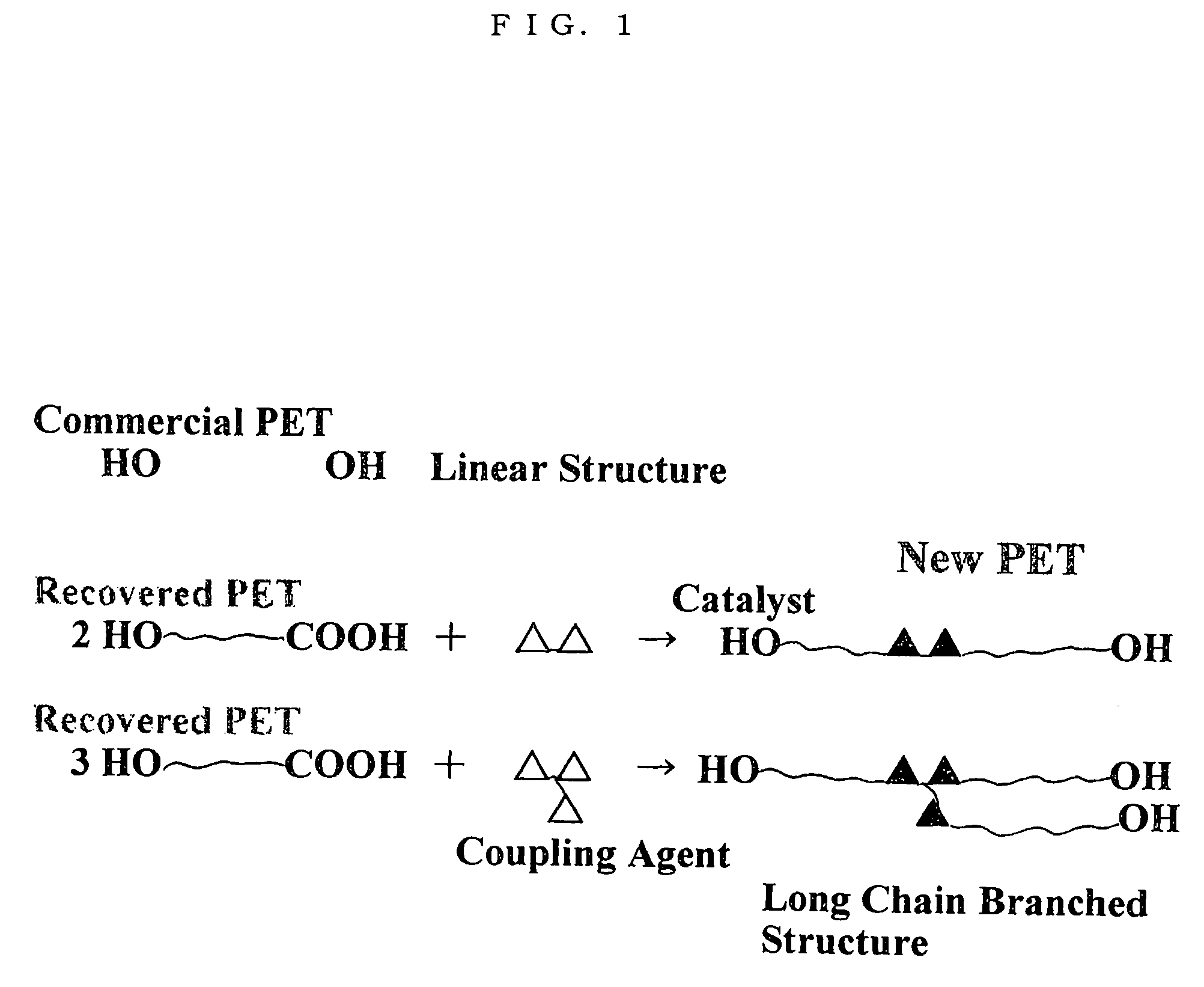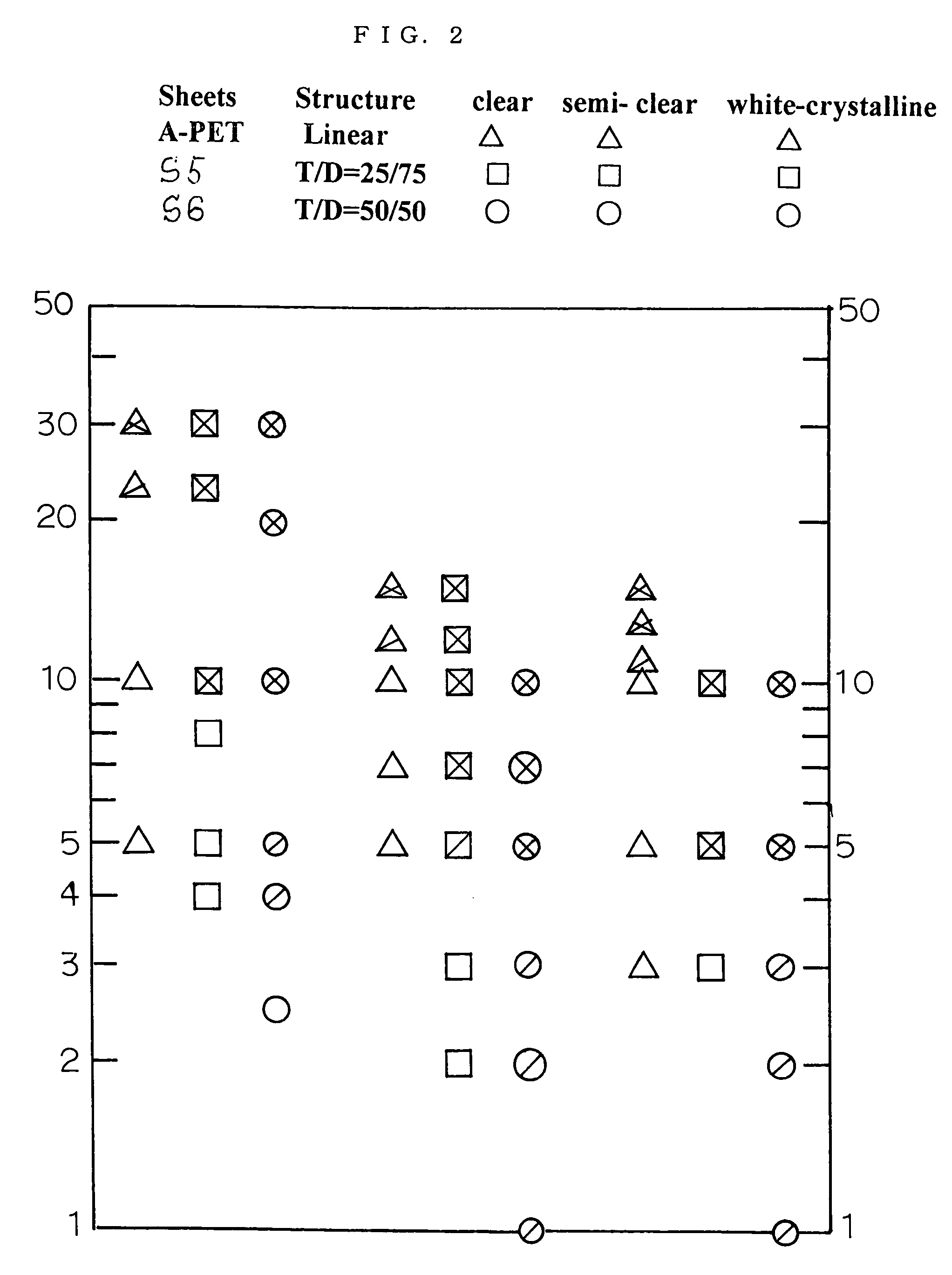Method of manufacturing heat-resistant mould articles made of polyethylene terephthalate polyesters
a technology of polyethylene terephthalate polyester and mould articles, which is applied in the field of manufacturing inexpensive heat-resistant transparent or white opaque mould articles, can solve the problems of difficult pressure-forming into mould articles, a-pets have disadvantages of whitening by crystallisation, embrittlement, deformation, etc., and achieve the effects of reducing the drawdown of sheets and boards, increasing the crystallisation rate, and melting viscosity
- Summary
- Abstract
- Description
- Claims
- Application Information
AI Technical Summary
Benefits of technology
Problems solved by technology
Method used
Image
Examples
examples
[0085]In Examples, the present invention will be described in detail.
[0086]Regarding polyesters, (1) intrinsic viscosity (IV), (2) melt flow rate (MFR), (3) swelling, (4) molecular weight, (5) mechanical property, (6) melt viscosity, (7) DSC, (8) crystallisation degree, (9) transparency, and (10) heat-resistance were evaluated. The evaluation methods are as follows.
(1) IV:
[0087]Using a 1:1 solvent mixture of 1,1,2,2-tetrachloroethane and phenol, and a Cannon-Fenske viscometer, IV values were measured at 25° C.
(2) MFR:
[0088]According to JIS K7210-20, MFR values were measured at a temperature of 280° C. and a load of 2.16 Kg.
(3) Swelling:
[0089]Using a melt indexer for MFR, samples were allowed to freely flow and run down at 280° C. and a load of 2.16 Kg. The samples were cut off when they had flowed down over 2.0 cm. The diameters of the samples were measured at their 5.0 mm point from their lowest end, and their swellings then were calculated by the following formula. Furthermore, th...
production examples 1-5
Coupling Agent Master Batches (f1)-(f5):
production example 1 (
f1)
[0108]Using a twin-screw extruder, manufactured by Berstorff Maschinenbau Gmbh, with an aperture of 43 mm in its diameter, L / D=43, and three-vented water shield type of vacuuming, 50 parts by weight of clear flakes, from Yono PET Bottle Recycle Co. Ltd., recycled from PET bottles, of 0.725 dl / g IV, of 56 g / 10 minutes MFR, of 10% swelling, and of 99.9% PET content, were dried with hot-air for around 12 hours at 120° C.; and 50 parts by weight of dried pellets of PETG 6763, from Eastman Chemical Co. Ltd., of 0.73 IV, of 1.27 density, ethyleneglycol cyclohexanedimethanol terephthalic acid co-polymer; were extruded at a preset temperature of 260° C., a screw-revolving speed of 200 rpm, around −600 mmHg in the first vent, around −670 mmHg in the third vent, and an automatic supply rate of 30 Kg / h, while 15 parts by weight of ethyleneglycol diglycidyl ether, a bifunctional epoxy compound (b), EPOLIGHT 40E from Kyoeisha Chemical Co. Ltd., a pale yellow liquid with an epoxy equivalent of...
PUM
| Property | Measurement | Unit |
|---|---|---|
| surface temperature | aaaaa | aaaaa |
| temperature | aaaaa | aaaaa |
| surface temperature | aaaaa | aaaaa |
Abstract
Description
Claims
Application Information
 Login to View More
Login to View More - R&D
- Intellectual Property
- Life Sciences
- Materials
- Tech Scout
- Unparalleled Data Quality
- Higher Quality Content
- 60% Fewer Hallucinations
Browse by: Latest US Patents, China's latest patents, Technical Efficacy Thesaurus, Application Domain, Technology Topic, Popular Technical Reports.
© 2025 PatSnap. All rights reserved.Legal|Privacy policy|Modern Slavery Act Transparency Statement|Sitemap|About US| Contact US: help@patsnap.com



